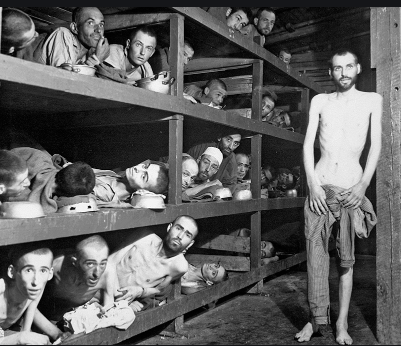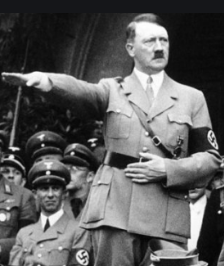|

Historic Remembrance - "Holocaust"
|
Since 1945, the word “Holocaust,” has taken on a new and horrible meaning: the mass murder of some 6 million European Jews (as well as millions of others, including Gypsies and homosexuals) by the German Nazi regime during the Second World War. To the anti-Semitic Nazi leader Adolf Hitler, Jews were an inferior race, an alien threat to German racial purity and community. After years of Nazi rule in Germany, during which Jews were consistently persecuted, Hitler’s “final solution”–now known as the Holocaust–came to fruition under the cover of world war, with mass killing centers constructed in the concentration camps of occupied Poland. The word “Holocaust,” from the Greek words “holos” (whole) and “kaustos” (burned).
The twin goals of racial purity and spatial expansion were the core of Hitler’s world view, and from 1933 onward they would combine to form the driving force behind his foreign and domestic policy. At first, the Nazis reserved their harshest persecution for political opponents such as Communists or Social Democrats. The first official concentration camp opened at Dachau (near Munich) 1933, and many of the first prisoners sent there were Communists.
Beginning in late 1941, the Germans began mass transports from the ghettoes in Poland to the concentration camps, starting with those people viewed as the least useful: the sick, old and weak and the very young. The first mass gassings began at the camp of Belzec, near Lublin, on March 17, 1942. Five more mass killing centers were built at camps in occupied Poland, including Chelmno, Sobibor, Treblinka, Majdanek and the largest of all, Auschwitz-Birkenau.
From 1942 to 1945, Jews were deported to the concentration
|
|
camps from all over Europe, including German-controlled territory as well as those countries allied with German
The heaviest deportations took place during the summer and fall of 1942, when more than 3,00,000 people were deported from the Warsaw ghetto alone. Fed up with the deportations - disease and constant hunger- the inhabitants of the Warsaw Ghetto rose up in armed revolt. The Warsaw Ghetto Uprising from April 19-May 16, 1943 ended in the death of 7,000 Jews, with 50,000 survivors sent to extermination camps. But the resistance fighters had held off the Nazis for almost a month, and their revolt inspired at camps and ghettos across German-occupied Europe. Though the Nazis tried to keep operation of camps secret, Eyewitnesses brought reports of Nazi atrocities in Poland to the Allied governments, who were harshly criticized news of the Holocaust.
At Auschwitz alone, more than 2 million people were murdered in a process resembling a large-scale industrial operation. A large population of Jewish and non-Jewish inmates worked in the labor camp there. Though only Jews were gassed, thousands of others died of starvation or disease. And in 1943, eugenicist Josef Mengele arrived in Auschwitz to begin his infamous experiments on Jewish prisoners. His special area of focus was conducting medical experiments, injecting them with everything from petrol to chloroform under the guise of giving them medical treatment. His actions earned him the nickname “the Angel of Death.”
By the spring of 1945, German leadership was dissolving amid internal dissent. In his last will and political testament, dictated in a German bunker that April 29, Hitler blamed the war on
|
|
|
“International Jewry and its helpers” and urged the German leaders and people to follow “the strict observance of the racial laws. The following day, Hitler committed suicide. Germany’s formal surrender in World War II came barely a week later, on May 8, 1945
German forces had begun evacuating many of the death camps in the fall of 1944, sending inmates under guard to march further from the advancing enemy’s front line. These so-called “death marches” continued all the way up to the German surrender, resulting in the deaths of some 2,50,000 to 3,75,000 people. In his classic book “Survival in Auschwitz,” the Italian Jewish author Primo Levi described his own state of mind, as well as that of his fellow inmates in Auschwitz on the day before Soviet troops arrived atthe camp in January 1945: “We lay in a world of death and phantoms. The last trace of civilization had vanished around and inside us. The work of bestial degradation, begun by the victorious Germans, had been carried to conclusion by the Germans in defeat.”
The wounds of the Holocaust–known in Hebrew as Shoah, or catastrophe–were slow to heal. Survivors of the camps found it nearly impossible to return home, as in many cases they had lost their families and been denounced by their non-Jewish neighbors. As a result, the late 1940s saw an unprecedented number of refugees, POWs and other displaced populations moving across Europe.
In an effort to punish the villains of the Holocaust, the Allies held the Nuremberg Trials of 1945-46, which brought Nazi atrocities to horrifying light. Increasing pressure on the Allied powers to create a homeland for Jewish survivors of the Holocaust would lead to a mandate for the creation of Israel in 1948.
Over the decades that followed, ordinary Germans struggled with the Holocaust’s bitter legacy, as survivors and the families of victims sought restitution of wealth and property confiscated during the Nazi years. Beginning in 1953, the German government made payments to individual Jews and to the Jewish people as a way of acknowledging the German people’s responsibility for the crimes committed in their name.
|
|
